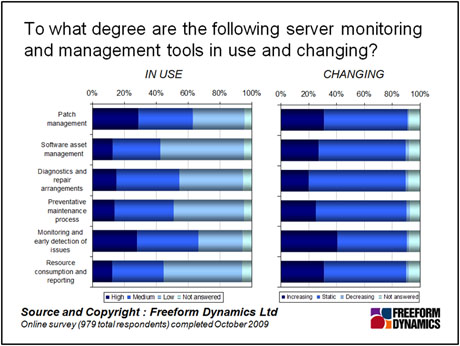According to Freeform Dynamics research, many IT departments are seeking to become better aligned with business needs and are looking to ensure that systems and IT resources are being deployed more dynamically to support fluctuating business goals.
One of the critical success factors will be investing in up–to-date, and crucially, integrated management tools: only in this way will IT managers and administrators obtain a significant influence on the ability to deliver IT services in a cost effective manner.
Sound sensible? Certainly, but our research tells us that many companies have no clear view on how to articulate the benefits of doing so, ending up with piecemeal evolution and fragmentation of their management tools, which in turn leads to difficulties delivering on what the business needs from IT.
The figure below shows that current attitudes may not be compatible with managing IT service delivery effectively, never mind the greater task of optimising resource alignment with business priorities. A significant number of organisations see plenty of room for their management tool usage to be supplemented, even in simpler areas of systems administration. For example, we know that software asset management is not used effectively by many organisations, despite its ability to reduce software license spend and minimise potential legal embarrassment. Equally the use of IT resource consumption tools and the reporting on IT services are also remarkably low, despite the fact that such tools have potential roles to play in “charge back” scenarios or in IT budget justification processes
.

From the figure, we can see how IT managers recognise that the tools they use to manage their systems are likely to be asked to do more in the future, not less, as the business looks for IT to become more responsive to changing requirements. In addition, the pressure to reduce operational costs increases the need for tools to help automate IT management processes. It should also be noted that new technologies such as virtualisation are enhancing the requirement for such tools to be better integrated across the systems management domain.
Given that the need for better systems management tools is clear, will investment in them be forthcoming? Perhaps not. We know from our own experience, anecdotal stories and research evidence that making the case for procuring new systems and service management solutions is rarely straightforward.
There is also evidence that IT is most successfully aligned with the business when investment in up-to-date management tools is a continuous cycle, happening all the time or on an annual basis, rather than just on a three year or upgrade cycle. However, our investigations have highlighted that few business managers recognise the link between the effective use of good systems management tools and the quality of the IT services they enjoy. And meanwhile, a significant proportion of organisations have not made major investments in their systems management tools within the last three years.
In some scenarios it may be possible to use “wiggle room” in the existing budget to deliver better integration between management tools. If well handled it may be possible to free up other areas of budget, for example by reducing operational costs as a consequence of better systems management to allow for investment in tools or integration. Whilst possible in theory, we have to recognise that not all organisations permit such a degree of flexibility within the overall spend.
While few administrators are happy with what they have available to them today, it is apparent that many IT systems managers need to improve how they make the business case for investment in systems management tools, as well as communicating the business benefits of using these systems effectively. Without doing so, they may simply be condemning themselves to more of the same in the future. For some, the vision of more dynamic IT may remain a long way off.
Tony is an IT operations guru. As an ex-IT manager with an insatiable thirst for knowledge, his extensive vendor briefing agenda makes him one of the most well informed analysts in the industry, particularly on the diversity of solutions and approaches available to tackle key operational requirements. If you are a vendor talking about a new offering, be very careful about describing it to Tony as ‘unique’, because if it isn’t, he’ll probably know.





Have You Read This?
From Barcode Scanning to Smart Data Capture
Beyond the Barcode: Smart Data Capture
The Evolving Role of Converged Infrastructure in Modern IT
Evaluating the Potential of Hyper-Converged Storage
Kubernetes as an enterprise multi-cloud enabler
A CX perspective on the Contact Centre
Automation of SAP Master Data Management
Tackling the software skills crunch